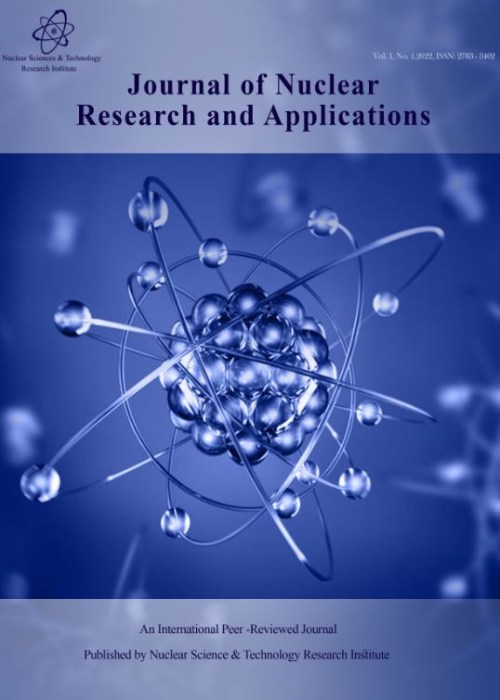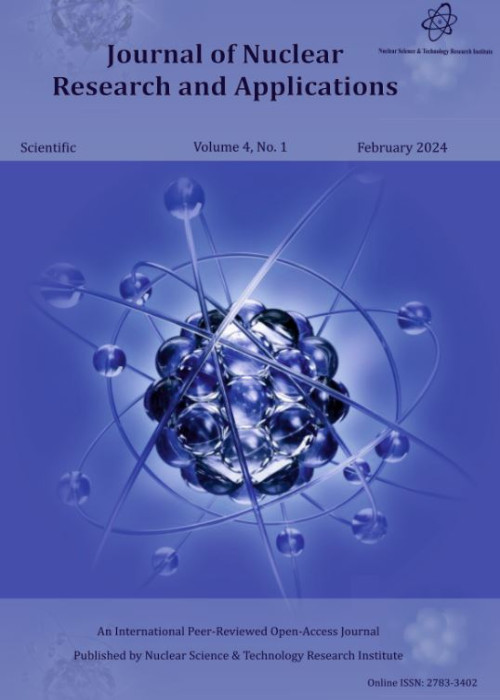فهرست مطالب

Journal of Nuclear Research and Applications
Volume:3 Issue: 2, Spring 2023
- تاریخ انتشار: 1402/03/31
- تعداد عناوین: 6
-
-
Pages 1-14
This paper presents the optimization of a system of square cascades for separating the middle components of xenon. It also presents the optimal use of square cascades in this system. As an example, the separation of 130Xe, an element whose middle isotope is much more complex than any of the other isotopes of xenon, is provided. The Grey Wolf Algorithm is applied for optimization. and the parameters of cascade feed flow rate, cut off the cascade, feed location, feed flow of gas centrifuges (GC), and the cut of the first stage are optimized in such a way that the maximum recovery of the target isotope and the maximum cascade capacity are achieved. Based on the optimization results, the more steps the cascade has, the fewer separation steps are needed for the nine selected cascades with 180 GCs. As a result, both the recovery factor and the amount of product increase.
Keywords: Square Cascade, 130Xe, GWO Optimization Algorithm, Centrifuge, Middle Isotopes -
Pages 15-21
Nuclear-grade zirconium alloys' properties are very similar to those of pure zirconium (Zr) because in most cases they contain more than 95% of Zr atoms. They have extensive applications in the nuclear industry, especially in fuel cladding. In this work, for the atomic simulations, we have used an ADP model interatomic potential. The calculated lattice properties of Zr-1%Nb show a very good agreement with experiments. Investigation of the possibility of a di-vacancy formation showed that it is possible only for the first and second nearest neighbor positions. It shows that at zero pressure, the Nb atoms in the alloy tend to join and create Nb clusters. However, under external pressure, the Nb clusters become less stable, tending to decay into smaller ones.
Keywords: Zirconium-Niobium alloy, Defect, Di-vacancy, Niobium Clusters, Pressure -
Pages 22-26
A beta-voltaic battery design can be used to evaluate the functionality of the GEANT4 code and COMSOL Multiphysics software. The spatial distribution of the deposited energy for the beta particles in the semiconductor transducer has been simulated by using the GEANT4 and then, the electron-hole pair generation rate has been obtained. Subsequently, output performances of the battery such as the current-voltage (I–V) characteristics and the maximum electrical power have been determined by using the COMSOL Multiphysics in which the electron-hole pair generation rate from the GEANT4 simulation was utilized as input. Validation is done by considering an optimized planar betavoltaic battery. The results of the current study have been compared with other articles. The results are in good agreement and the relative errors are less than 8%. Our simulation model can be extended to the betavoltaic batteries with other semiconductors and radioactive isotopes and can provide a powerful tool for predicting the output performance and optimizing the betavoltaic batteries.
Keywords: Simulation, Model, Geant4, COMSOL Multiphysics, Betavoltaic Battery -
Pages 27-31
The current study investigates crystallization and phase separation of a borosilicate glass composition in the system Na2O–CaO–Al2O3–B2O3–SiO2 used for nuclear waste immobilization. At first, base glass composition was prepared by mixing and homogenizing of pure raw materials, melting in an alumina crucible and then casting in a stainless steel mold. Mo2O3 was added in constant values of 0.5, 1.5, 2.5, and 3.5% mole. XRD analysis was carried out to ensure no crystalline phases were formed. Heat treatment was performed at temperature intervals of 620, 650, 680 and 710°C. To study phase separation creation, SEM analysis was carried out. In the next step, acid leaching of phase-separated glasses was performed. Porosity analysis and measurement of specific surface area by BET were performed on acid-leached samples. The results show all samples demonstrate different amounts of phase separation. Also, the highest specific surface area was related to the sample containing 1.5% mole Mo2O3 with two acid-washing steps.
Keywords: Borosilicate glass, Vycor glass, Immobilization, Nuclear Waste -
Pages 32-48
We investigated the effects of different variables on cesium adsorption from aqueous solutions using a synthesized nanocomposite. The surfaces of synthesized spherical mesoporous silica were modified with potassium hexacyanoferrate and characterized by different techniques including XRD, FT-IR, SEM, TGA, and BET/BJH. The response surface methodology based on the central composite design was used to optimize cesium ion adsorption conditions such as the effects of initial cesium concentration, contact time, temperature, and pH. The equilibrium concentration data were analyzed by Langmuir, Freundlich, and Tempkin isotherm models. The isotherm studies showed that monolayer adsorption isotherm (Langmuir) is consistent with the experimental data. Based on kinetic studies, Blanchard's pseudo-second-order reaction kinetics model provides the best correlation of the experimental data. The initial concentration and pH were the most influential factors in cesium adsorption. The result showed the nanocomposite adsorbed cesium ions selectively even in the presence of high Na+, K+, and Sr2+ ions.
Keywords: Spherical SBA-15, Cesium, RSM, Hexacyanoferrate -
Pages 49-58
Droughts are one of the most significant factors disrupting crop growth and development. This study applied a nuclear technique based on thermalized neutrons to estimate maize yield losses arising from water shortages. The biomass consists of water and light hydrogen (1H), which slows down fast neutrons. Hence, thermalized neutrons can be a helpful proxy to determine crop losses. An experiment was conducted with four treatments related to various levels of water stress in three replications. At the end of the maize growing season,, wet weight of the samples was measured, and then the samples were put around an access tube of the Hydro-probe Neutron Meter to count thermalized neutrons. Thereafter, the samples were then transferred to the oven to measure dry weight and in turn, biomass water equivalent (BWE). Findings showed that the average values of the thermalized neutron count ratio were positively and negatively correlated with BWE and damage (%), respectively. The regression models estimating crop losses were cross-validated based on the leave-one-out technique. An absolute mean error equal to 15% and R2 greater than 0.6 indicate somewhat satisfactory performance of the models. This study was a breakthrough in the feasibility of applying these instruments. Further studies are recommended for practical applications.
Keywords: Damage, Biomass Water Equivalent, Hydro-probe Neutron Meter, Cross-Validation, Neutron-based Tools


